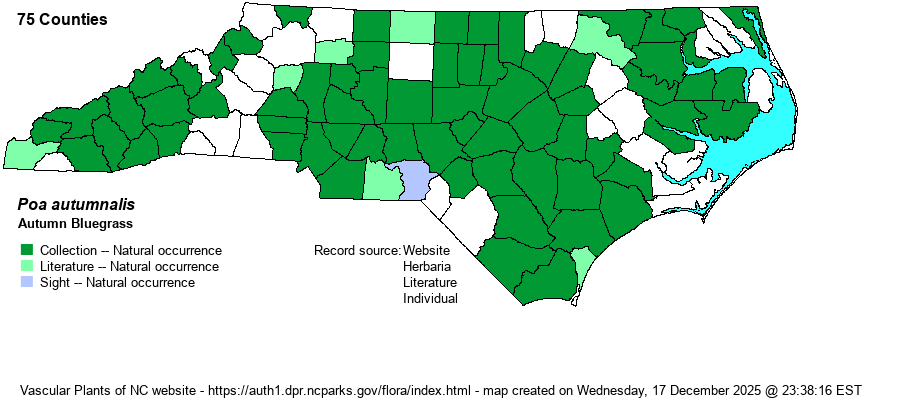| Author | Muhlenberg ex Elliott | |
| Distribution | Essentially throughout the state. Present gaps likely will be filled with additional collecting.
NJ to MI, south to FL and TX. | |
| Abundance | Frequent to common throughout. This species is oddly ranked by the NCNHP as S4, but it is clearly an S5 species. | |
| Habitat | Mesic to moist, nutrient rich, hardwood or hardwood-pine forests and woodlands -- both on slopes and in floodplains, including along stream banks. | |
| Phenology | Flowering and fruiting March-May. Note the unfortunate common and scientific names! | |
| Identification | These plants are loosely clumped perennials, 1-2.5 feet tall. Like some other NC Poa species, the inflorescences are composed of well-spaced whorls of 1-2 (-4) slender branches. Spikelets occur near the ends of the branches and lemmas have no tuft or web of hairs at the base (as opposed to our other look-alike species). | |
| Taxonomic Comments | None
The genus Poa contains some 500 species globally, about 70 in N.A. A typical Poa species has a number of basal leaves, few stem leaves, and a terminal, open inflorescence. The inflorescence is composed of well-spaced whorls of 2-6 skinny branches, usually with short side branchlets and these bearing spikelets. Branches may be strongly ascending, horizontal, or reflexed. Spikelets are composed of 2-6 florets and are generally laterally compressed. Each glume and lemma is acute to blunt, but seldom acuminate as in many Festuca species. Unlike Festuca and Bromus, most Poa species have a small wispy tuft of white hairs at the base of each floret. | |
| Other Common Name(s) | Sadly, none! | |
| State Rank | S4 [S5] | |
| Global Rank | G5 | |
| State Status | | |
| US Status | | |
| USACE-agcp | FAC link |
| USACE-emp | FAC link |

